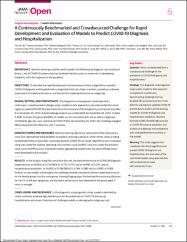| dc.contributor.author | Yan, Yao | |
| dc.contributor.author | Schaffter, Thomas | |
| dc.contributor.author | Bergquist, Timothy | |
| dc.contributor.author | Yu, Thomas | |
| dc.contributor.author | Prosser, Justin | |
| dc.contributor.author | Aydin, Zafer | |
| dc.contributor.author | Jabeer, Amhar | |
| dc.contributor.author | Brugere, Ivan | |
| dc.contributor.author | Gao, Jifan | |
| dc.contributor.author | Chen, Guanhua | |
| dc.contributor.author | Causey, Jason | |
| dc.contributor.author | Yao, Yuxin | |
| dc.contributor.author | Bryson, Kevin | |
| dc.contributor.author | Long, Dustin R. | |
| dc.contributor.author | Jarvik, Jeffrey G. | |
| dc.contributor.author | Lee, Christoph, I | |
| dc.contributor.author | Wilcox, Adam | |
| dc.contributor.author | Guinney, Justin | |
| dc.contributor.author | Mooney, Sean | |
| dc.date.accessioned | 2022-03-05T09:19:24Z | |
| dc.date.available | 2022-03-05T09:19:24Z | |
| dc.date.issued | 2021 | en_US |
| dc.identifier.issn | 2574-3805 | |
| dc.identifier.other | PubMed ID34633425 | |
| dc.identifier.uri | https //doi.org/10.1001/jamanetworkopen.2021.24946 | |
| dc.identifier.uri | https://hdl.handle.net/20.500.12573/1243 | |
| dc.description | This study was supported by the Clinical and Translational Science Awards Program National Center for Data to Health funding by the National Center for Advancing Translational Sciences at the National Institutes of Health (grant U24TR002306 [Ms Yan, Drs Schaffter, Bergquist, Guinney, and Mooney and Messrs Yu and Prosser]), Bill and Melinda Gates Foundation, the Institute for Translational Health Sciences (grant UL1 TR002319 [Dr Bergquist and Mooney and Mr Prosser]), and NDational Institutes of Health/National Institute of General Medical Sciences Anesthesiology and Perioperative Medicine Research Training (grant T32 GM086270 [Dr Long]). The CLEAR center was supported by the National Institute of Arthritis and Musculoskeletal and Skin Diseases (grant P30AR072572). | en_US |
| dc.description.abstract | IMPORTANCE Machine learning could be used to predict the likelihood of diagnosis and severity of illness. Lack of COVID-19 patient data has hindered the data science community in developing models to aid in the response to the pandemic.
OBJECTIVES To describe the rapid development and evaluation of clinical algorithms to predict COVID-19 diagnosis and hospitalization using patient data by citizen scientists, provide an unbiased assessment of model performance, and benchmark model performance on subgroups.
DESIGN, SETTING, AND PARTICIPANTS This diagnostic and prognostic study operated a continuous, crowdsourced challenge using a model-to-data approach to securely enable the use of regularly updated COVID-19 patient data from the University of Washington by participants from May 6 to December 23, 2020. A postchallenge analysis was conducted from December 24, 2020, to April 7, 2021, to assess the generalizability of models on the cumulative data set as well as subgroups stratified by age, sex, race, and time of COVID-19 test. By December 23, 2020, this challenge engaged 482 participants from 90 teams and 7 countries.
MAIN OUTCOMES AND MEASURES Machine learning algorithms used patient data and output a score that represented the probability of patients receiving a positive COVID-19 test result or being hospitalized within 21 days after receiving a positive COVID-19 test result. Algorithms were evaluated using area under the receiver operating characteristic curve (AUROC) and area under the precision recall curve (AUPRC) scores. Ensemble models aggregating models from the top challenge teams were developed and evaluated.
RESULTS In the analysis using the cumulative data set, the best performance for COVID-19 diagnosis prediction was an AUROC of 0.776 (95% CI, 0.775-0.777) and an AUPRC of 0.297, and for hospitalization prediction, an AUROC of 0.796 (95% CI, 0.794-0.798) and an AUPRC of 0.188. Analysis on top models submitting to the challenge showed consistently better model performance on the female group than the male group. Among all age groups, the best performance was obtained for the 25- to 49-year age group, and the worst performance was obtained for the group aged 17 years or younger.
CONCLUSIONS AND RELEVANCE In this diagnostic and prognostic study, models submitted by citizen scientists achieved high performance for the prediction of COVID-19 testing and hospitalization outcomes. Evaluation of challenge models on demographic subgroups and prospective data revealed performance discrepancies, providing insights into the potential bias and limitations in the models. | en_US |
| dc.description.sponsorship | Clinical and Translational Science Awards Program National Center for Data to Health - National Center for Advancing Translational Sciences at the National Institutes of Health U24TR002306
Bill & Melinda Gates Foundation
Institute for Translational Health Sciences UL1 TR002319
National Institutes of Health/National Institute of General Medical Sciences Anesthesiology and Perioperative Medicine Research Training T32 GM086270
United States Department of Health & Human Services
National Institutes of Health (NIH) - USA
NIH National Institute of Arthritis & Musculoskeletal & Skin Diseases (NIAMS) P30AR072572 | en_US |
| dc.language.iso | eng | en_US |
| dc.publisher | AMER MEDICAL ASSOC330 N WABASH AVE, STE 39300, CHICAGO, IL 60611-5885 | en_US |
| dc.relation.isversionof | 10.1001/jamanetworkopen.2021.24946 | en_US |
| dc.rights | info:eu-repo/semantics/openAccess | en_US |
| dc.title | A Continuously Benchmarked and Crowdsourced Challenge for Rapid Development and Evaluation of Models to Predict COVID-19 Diagnosis and Hospitalization | en_US |
| dc.type | article | en_US |
| dc.contributor.department | AGÜ, Mühendislik Fakültesi, Bilgisayar Mühendisliği Bölümü | en_US |
| dc.contributor.institutionauthor | Aydin, Zafer | |
| dc.contributor.institutionauthor | Jabeer, Amhar | |
| dc.identifier.volume | Volume 4 Issue 10 | en_US |
| dc.relation.journal | JAMA NETWORK OPEN | en_US |
| dc.relation.publicationcategory | Makale - Uluslararası - Editör Denetimli Dergi | en_US |


















